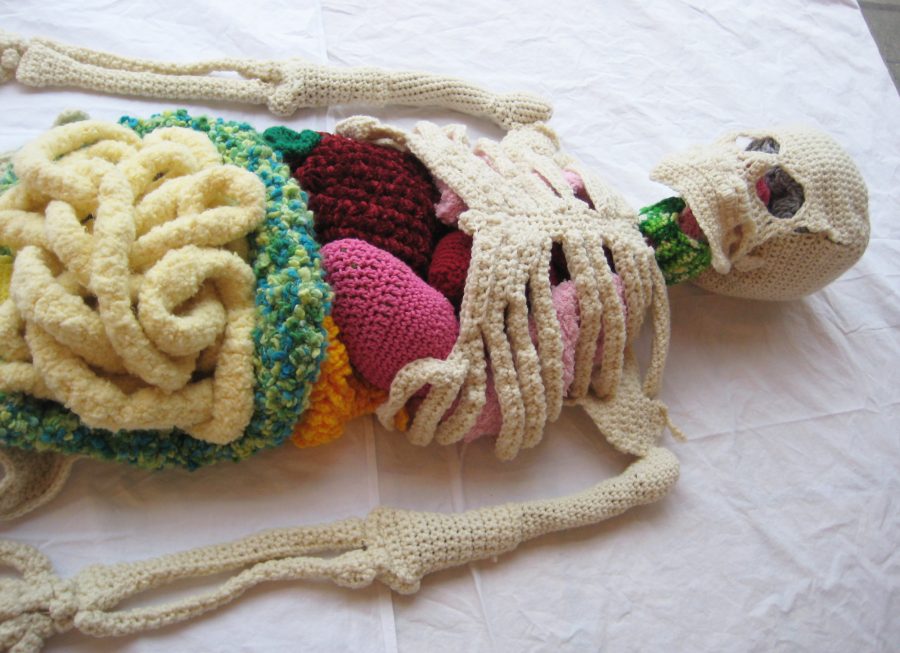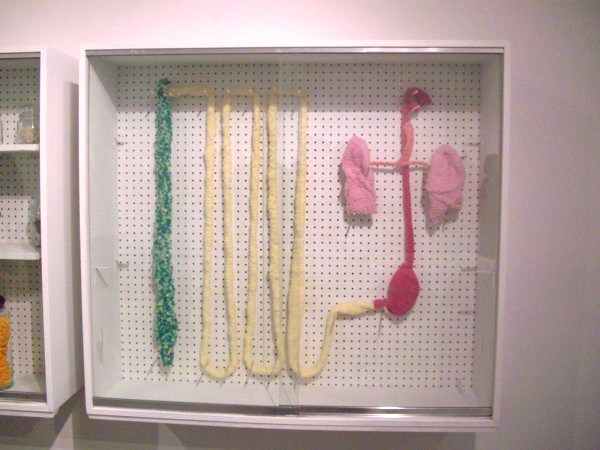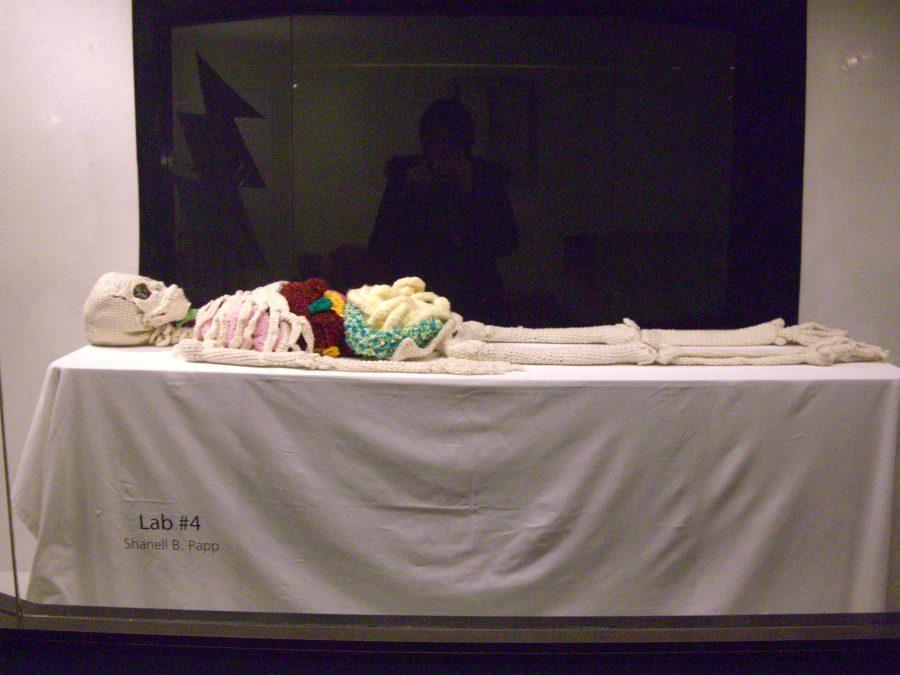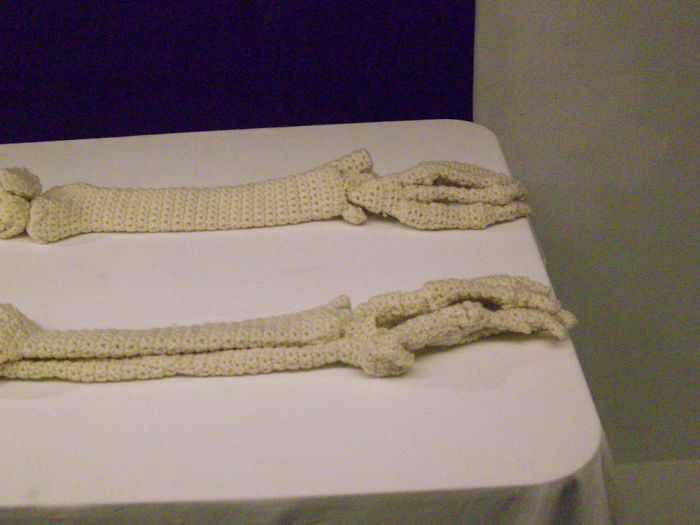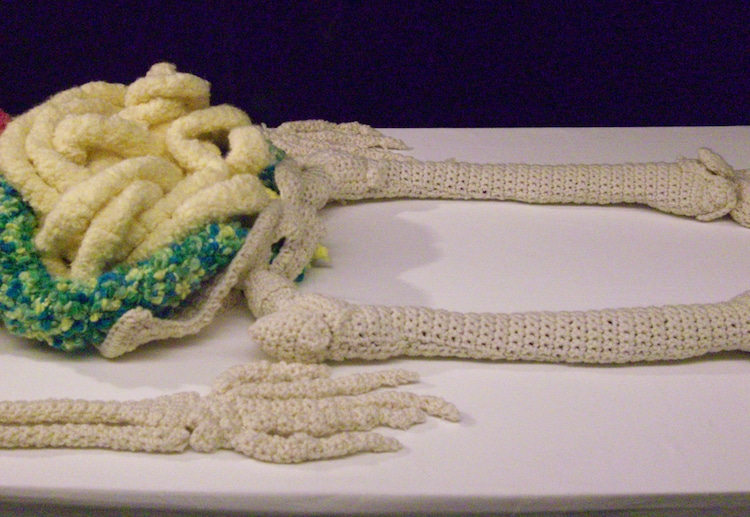[Most Recent Entries] [Calendar View]
Monday, August 5th, 2019
- Do as artist Shanell Papp did, above, and crochet one.
| Time | Event |
| 8:00a | An Artist Crochets a Life-Size, Anatomically-Correct Skeleton, Complete with Organs
How to make a life-sized facsimile of a human skeleton: or The latter will take considerably more time and attention on your part. Papp gave up all extracurricular activities for four months to hook the woolen skeleton around her work and school schedule. Equipping it with internal organs ate up another four. To ensure accuracy, Papp armed herself with anatomical textbooks and an actual human skeleton on loan from the University of Lethbridge, where she was an undergrad. The brain has gray and white matter, there's marrow in the bones, the stomach contains half-digested wool food, and the intestines can be unspooled to a realistic length.
The grueling 2006 project did not exhaust her fascination for the intricacies of human anatomy. The University of Saskatchewan granted her open access to draw in the gross anatomy lab while she pursued her MFA.
As she told MICE magazine:
The finished piece, which is displayed supine on a gurney she nabbed for free during a mortuary renovation, incorporates many of Papp’s other abiding interests: horror, medical history, Frankenstein, crime investigation, and mortuary practices. Papp, who taught herself how to crochet from books as a child, using whatever yarn found its way to her grandma’s junk shop, appreciates how her chosen medium adds a layer of homey softness and familiarity to the macabre. It’s also not lost on her that fiber arts, often dismissed as too “crafty” by the establishment, were an important component of 70s-era feminist art, though in her view, her work is more of a statement on the history of textile manufacturing, which is to say the history of labor and class struggle.
See more of Shanell Papp’s work here. All images in this post by Shanell Papp. Related Content: Behold an Anatomically Correct Replica of the Human Brain, Knitted by a Psychiatrist The Beautiful Math of Coral & Crochet Ayun Halliday is an author, illustrator, theater maker and Chief Primatologist of the East Village Inkyzine. Join her in NYC on Monday, September 9 for another season of her book-based variety show, Necromancers of the Public Domain. Follow her @AyunHalliday. An Artist Crochets a Life-Size, Anatomically-Correct Skeleton, Complete with Organs is a post from: Open Culture. Follow us on Facebook, Twitter, and Google Plus, or get our Daily Email. And don't miss our big collections of Free Online Courses, Free Online Movies, Free eBooks, Free Audio Books, Free Foreign Language Lessons, and MOOCs. |
| 11:00a | The Authentic Vivaldi’s The Four Seasons: Watch a Performance Based on Original Manuscripts & Played with 18th-Century Instruments Last week we featured a performance of Pachelbel's Canon as faithful as possible to how Pachelbel originally composed it, as well as to the instruments and playing styles of the era in which he lived. Today we offer another performance by the same ensemble, San Francisco' Voices of Music, this one of an even more beloved piece: Antonio Vivaldi's The Four Seasons. In the video above, violinist Cynthia Miller Freivogel joins Voices of Music to play the suite's "Winter" concerto on such genuinely early 18th-century instruments as the baroque organ, the Italian single manual harpsichord, and the archlute. "Of the many composers who helped to bring the Italian Baroque style to its zenith at the beginning of the 18th century, Antonio Vivaldi stands out as perhaps the most creative," says the web site of the Redlands Symphony. "Like Bach, his energy was primarily directed toward perfecting existing forms rather than creating new ones. Within the works of Vivaldi, we see a perfection of the 17th century Italian concerto and opera forms." And in the case of The Four Seasons, made up as it is of one concerto representing each quarter of the year accompanied by a sonnet on the spirit of that season, Vivaldi made "a conscious attempt to write programmatic works. They are, in fact, one of the earliest attempts to compose music of this type." For this video, Voices of Music's official notes explain, a "new edition" of The Four Seasons "was prepared from the original sources, prints and manuscripts for Vivaldi's music. In addition, a digital overlay has been created for Vivaldi's sonnets which were inlaid into the original engraving: click the CC button to view the sonnet and the gear icon to choose your preferred language." This performance of one part of Vivaldi's best-known compositions, sounding as close as we can possibly get today to the way Vivaldi himself must have heard it, will be seasonally appropriate for southern-hemisphere Open Culture readers now in the middle of their own winter. As for readers in the summertime of the northern hemisphere — well, nine and a half minutes of 17th-century wintertime may be just what they need to cool down. Related Content: Why We Love Vivaldi’s “Four Seasons”: An Animated Music Lesson Vivaldi’s Four Seasons Brought to Life in Sand Animations by the Hungarian Artist Ferenc Cakó 14-Year-Old Girl’s Blistering Heavy Metal Performance of Vivaldi Based in Seoul, Colin Marshall writes and broadcasts on cities, language, and culture. His projects include the book The Stateless City: a Walk through 21st-Century Los Angeles and the video series The City in Cinema. Follow him on Twitter at @colinmarshall, on Facebook, or on Instagram. The Authentic Vivaldi’s The Four Seasons: Watch a Performance Based on Original Manuscripts & Played with 18th-Century Instruments is a post from: Open Culture. Follow us on Facebook, Twitter, and Google Plus, or get our Daily Email. And don't miss our big collections of Free Online Courses, Free Online Movies, Free eBooks, Free Audio Books, Free Foreign Language Lessons, and MOOCs. |
| 2:00p | RIP D.A. Pennebaker: Watch Scenes from His Groundbreaking Bob Dylan Documentary Dont Look Back Something happened to popular culture in the late 1960s, and we who seek to understand exactly what owe a debt of gratitude to the documentary filmmaker D.A. Pennebaker, who died last week. That goes for those us who never experienced those heady times ourselves; those of us who did (and may have found the times a bit too heady to recall with any clarity); and even those of us not quite young enough to fathom what was going on at the time, such as those already in middle age by the Summer of Love. Pennebaker was himself a member of that generation, but the films that came out of his coverage of the Monterey Pop Festival — whose performers included Janis Joplin, Ravi Shankar, Jefferson Airplane, The Who, and Jimi Hendrix — reveal that he could see something big was happening. Pennebaker's filmmaking also brought him into contact with the likes of John Lennon, David Bowie, Otis Redding, and Bob Dylan, the latter being the star of Pennebaker's first music film Dont Look Back [sic]. Released in 1967 but shot in 1965, it observes the singer's tour of England that year as well as the events surrounding it, offering what Roger Ebert called, when the film first came out, "a fascinating exercise in self-revelation carried out by Bob Dylan and friends," a group that includes such generational icons as Joan Baez and Donovan. Alas, "the portrait that emerges is not a pretty one," rendered as it is by the cinéma vérité style Pennebaker had been developing for more than a decade. That was made possible in part by the advent of synchronous-sound cameras that could capture real speech on location — "what people said to each other," in Pennebaker's words, as opposed to "what you thought up on a yellow pad.” All this exposed Dylan, in Ebert's eyes, as "immature, petty, vindictive, lacking a sense of humor, overly impressed with his own importance and not very bright." In both his original review of Dont Look Back and his revisitation in 1998, when the film was selected for preservation in the U.S. Library of Congress' National Film Registry, he highlights the scene of Dylan's interview with Time London correspondent Horace Freeland Judson. Then, as now, a performer who prefers to be publicized on his own terms, Dylan pushes back against any perceived attempt to define or explain him, especially by a relatively old-school institution like Time. In this young Bob Dylan we have an embodiment of the late-60s youth spirit: amusingly defiant and prolifically creative, if also irresponsible and arrogant. (As Ebert wrote in 1998, "Did we actually once take this twirp as our folk god?") Pennebaker discusses Dylan and Dont Look Back in the clip at the top of the post, which comes from a longer interview available here. He also gets into 1966's Eat the Document, the never-officially-released follow-up to Dont Look Back previously featured here on Open Culture. In the Criterion Collection video just above, Patti Smith — somehow never the subject of a Pennebaker film herself — reflects on the role Dylan played in her life. "He was like my imaginary boyfriend," Smith says of the singer. "The first time I saw Dont Look Back, I had just come to New York to live." She describes the intersection of the move and the movie as "a pivotal moment, because it encompassed everything for me: it encompassed the hubris of youth, it encompassed art, poetry, the perfect sunglasses, everything." She saw the film so many times that she "knew all the dialogue" — dialogue that Pennebaker just happened to capture, but which has long since become part of the culture. Related Content: Do Look Back: Pennebaker and Marcus Talk Bob Dylan Bob Dylan Shares a Drug-Hazed Taxi Ride with John Lennon (1966) Jefferson Airplane Plays on a New York Rooftop; Jean-Luc Godard Captures It (1968) Watch the First Trailer for Martin Scorsese’s New Film, Rolling Thunder Revue: A Bob Dylan Story Andy Warhol’s ‘Screen Test’ of Bob Dylan: A Classic Meeting of Egos Based in Seoul, Colin Marshall writes and broadcasts on cities, language, and culture. His projects include the book The Stateless City: a Walk through 21st-Century Los Angeles and the video series The City in Cinema. Follow him on Twitter at @colinmarshall, on Facebook, or on Instagram. RIP D.A. Pennebaker: Watch Scenes from His Groundbreaking Bob Dylan Documentary Dont Look Back is a post from: Open Culture. Follow us on Facebook, Twitter, and Google Plus, or get our Daily Email. And don't miss our big collections of Free Online Courses, Free Online Movies, Free eBooks, Free Audio Books, Free Foreign Language Lessons, and MOOCs. |
| 4:42p | Worlds of Ursula K. Le Guin: Stream Online (for a Limited Time) a New Documentary Exploring the Life & Work of the Legendary Sci-Fi Writer “There are a lot of dystopias around these days,” writes Kim Stanley Robinson in his recent essay “Dystopia Now.” This, of course, “makes sense, because we have a lot of fears about the future.” We also have a lot of fears about the present, which get mapped onto the future in dystopian fiction, a genre that has become “part of our all-encompassing hopelessness.” Dystopias feel familiar, even comforting, in that no matter how bad things are, they are perhaps not quite as bad yet as the darkest visions of science fiction. We might still change course if we can finally heed the warnings. But literary and cinematic pessimism, either as grim escapism or a wake-up call, “has done its job,” Robinson argues, “it’s old news now, perhaps it’s self-indulgence to stay stuck in that place any more.” Another legendary sci-fi writer, Ursula K. Le Guin agreed. “We keep writing dystopias,” she remarked in a 2017 essay, “instead of envisioning a better world.” Le Guin, who passed away last year, wrote of “ambiguous,” “clearsighted,” and “troubled” utopias. And she practiced, over the course of her long career, what Robinson calls our current “task at hand”—“to imagine ways forward to that better place." We may not see much reason for optimism, but utopian thinking, "is realistic: things could be better." An anarchist, feminist, and environmentalist, Le Guin might be called an “ideological” writer, but not in the derogatory sense the word implies. All artists have ideological frameworks, whether they’re aware of them or not, and Le Guin was very much aware of the lenses she used to see the world, what Robinson defines as “the imaginary relationship to our real conditions of existence.” She consciously restructured her work to imagine new worlds in terms outside the oppressively hegemonic norms that govern ours, norms created by what she called the “yang” desire for absolute control. “I had to rethink my entire approach to writing fiction,” she says above in Worlds of Ursula K. Le Guin, a new PBS documentary directed by Arwen Curry, available free to stream for a limited time. “It was important,” Le Guin goes on, “to think about privilege and power and domination in terms of gender, which is something science fiction and fantasy had not done.” In so doing, Le Guin showed her readers it was possible to imagine functional, believable, even attainable alternatives to stark realities that seem too deeply entrenched to ever change. She showed other sci-fi and fantasy writers that they could do the same. The documentary features appearances from contemporaries and successors to Le Guin’s world-building brilliance, including Margaret Atwood, Samuel R. Delany, Analee Newitz, China Miéville, Nel Gaiman, Michael Chabon, and David Mitchell, all of whom cite her as an influence and inspiration. (“I read A Wizard of Earthsea,” says Mitchell, “and things rearranged in my head.”) In a way, reading Le Guin for the first time feels like being given a pair of VR glasses through which to see what’s truly possible, if only we had the will to collectively imagine it into being. She did not think of utopianism as an eternal state of perfection or a thought experiment, but as a “process,”as Kelly Lynn Thomas writes at The Millions, of “reflection and adjustment, learning and growth… communication and respect, self-awareness and honesty.” Though the word is typically deployed to describe dangerous naivete or pie-in-the-sky thinking, utopianism need not be a grasping after “rational human control of human life,” Le Guin wrote. Utopias always contain some measure of dystopia, she recognized. But she proposed that we find balance by imagining what she calls “yin utopias,” spaces that involve "acceptance of impermanence and imperfection, a patience with uncertainty and the makeshift, a friendship with water, darkness, and the earth.” Such are the ideals that informed her vast imaginative output over the course of nearly 60 years, including 21 novels, 11 volumes of short stories, essay collections, children’s books, and poetry. In Worlds of Ursula K. Le Guin, we learn how she developed and refined her creative vision, and her critiques of totalizing “yang" utopianism and its despairing opposite. The film is available to stream in full online for a limited time. Watch it above or on PBS's American Masters page before it’s gone. Related Content: Ursula K. Le Guin’s Daily Routine: The Discipline That Fueled Her Imagination Ursula K. Le Guin Names the Books She Likes and Wants You to Read Josh Jones is a writer and musician based in Durham, NC. Follow him at @jdmagness Worlds of Ursula K. Le Guin: Stream Online (for a Limited Time) a New Documentary Exploring the Life & Work of the Legendary Sci-Fi Writer is a post from: Open Culture. Follow us on Facebook, Twitter, and Google Plus, or get our Daily Email. And don't miss our big collections of Free Online Courses, Free Online Movies, Free eBooks, Free Audio Books, Free Foreign Language Lessons, and MOOCs. |
| << Previous Day |
2019/08/05 [Calendar] |
Next Day >> |
